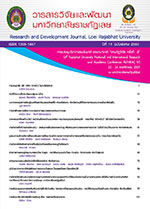ภูมิปัญญาอาหารชาติพันธุ์เพื่อสุขภาพของชาวไทยเขมร ไทยกูยและไทยลาวในเขตอีสานใต้
Keywords:
ภูมิปัญญาอาหารชาติพันธุ์เพื่อสุขภาพ, ชาติพันธุ์ไทยเขมร ชาติพันธุ์ไทยกูย, ชาติพันธุ์ไทยลาว, wisdom healthy ethnic food, Thai Khmers ethnic group, Thai Kuis ethnic group and Thai Laos ethnic groupAbstract
การวิจัยเรื่องภูมิปัญญาอาหารชาติพันธุ์เพื่อสุขภาพของชาวไทยเขมร ไทยกูยและไทยลาวในเขตอีสานใต้ เป็นการวิจัยเชิงคุณภาพ โดยใช้วิธีการวิจัยเชิงปฏิบัติการแบบมีส่วนร่วม ระหว่างกลุ่มชาติพันธุ์ในพื้นที่เป้าหมายกับนักวิจัย ใช้วิธีสืบค้นข้อมูลจากเอกสารและข้อมูลที่ได้จากการสังเกต การสัมภาษณ์กลุ่มตัวอย่าง ด้วยวิธีการสัมภาษณ์โดยใช้โครงสร้างการสัมภาษณ์ (Interview guide) ด้วยเทคนิคสโนว์บอล (Snowball technique) เจาะจงเฉพาะผู้มีประสบการณ์และความเชี่ยวชาญในการประกอบอาหารชาติพันธุ์ การสนทนากลุ่ม (Focus group discussion) และการปฏิบัติการทดลองประกอบอาหารตามสูตรที่ได้กาหนดร่วมกัน โดยมีวัตถุประสงค์ 1) เพื่อศึกษาภูมิปัญญาอาหารชาติพันธุ์เพื่อสุขภาพของชาวไทย-เขมร ไทย-กูย และไทย-ลาวและวัตถุดิบที่นามาใช้ในการประกอบอาหาร 2) เพื่อศึกษาสำรับอาหารเพื่อสุขภาพที่นามารับประทานในชีวิตประจาวัน ของกลุ่มชาติพันธุ์เขมร กูย และลาว 3) เพื่อศึกษาคุณค่าทางอาหารและสรรพคุณของพืชผักต่างๆ ที่นำมาประกอบอาหารเพื่อการดูแลสุขภาพของชาติพันธุ์เขมร กูย และลาว
ผลการวิจัยพบว่า อาหารเพื่อสุขภาพของชาวไทยเขมร และไทยกูยในเขตอีสานใต้ อาหารประเภทต่างๆ ส่วนผสมหลักจะใช้น้ำปลาร้าเป็นเครื่องปรุงเกือบทุกประเภทและชนิดของอาหาร ส่วนพืชผักที่เป็นพื้นฐานของการประกอบอาหารจะประกอบไปด้วยสมุนไพร เช่น ขิง ข่า ตะไคร้ พริก หอมแดง เกือบทุกประเภทของอาหารเช่นเดียวกัน นอกจากนั้นยังมีพืชผักชนิดต่างๆ ที่หาได้จากท้องถิ่น นำมาปรุงเข้ากับเนื้อสัตว์ที่หาได้ในท้องถิ่นนามาประกอบเป็นอาหารรับประทานเป็นประจำในชีวิตประจาวันตั้งแต่บรรพบุรุษจนถึงปัจจุบัน พืชผักชนิดต่างๆ มีคุณสมบัติทางยาช่วยป้องกัน รวมทั้งการรักษาโรคต่างๆ ได้
อาหารชาติพันธุ์ของชาวไทยเขมรและไทยกูย ได้แก่ อาหารจาพวก แกง ต้ม ห่อหมก น้ำพริกและปิ้งย่าง การเรียกชื่ออาหาร เรียกชื่อตามภาษาท้องถิ่น เช่น ละแวกะดาม (แกงคั่วปู) ส่วนอาหารชาติพันธุ์ของชาวไทยลาว ได้แก่ อาหารจำพวก ลาบ ก้อย หมก อู๋ อ่อม แกง ต้ม ซุป ปิ้ง ย่าง ดอง คั่ว ลวก นึ่ง ตา แจ่ว ป่น เมี่ยง เครื่องปรุงที่จะขาดไม่ได้ในการประกอบหาร คือ น้ำปลาร้า อาหารประเภทต้ม อ่อม อู๋ หมก มักจะมีส่วนผสมของผักแขยงเป็นส่วนผสมหลัก ส่วนอาหารประเภทแกง เช่น แกงหน่อไม้ แกงเห็ด มักจะมีส่วนผสมของย่านางเป็นส่วนผสมหลัก
สำรับอาหารชาติพันธุ์เพื่อสุขภาพของชาวไทยเขมร ไทยกูยและไทยลาวในเขตอีสานใต้ มักจะจัดสำรับอาหารเพียง 1-2 อย่าง กลุ่มชาติพันธุ์ชาวไทยเขมรและไทยกูยมักจะมีน้ำพริกเป็นเมนูประจาเกือบทุกมื้ออาหาร โดยการรับประทานกับผักเครื่องเคียงชนิดต่างๆ ตามฤดูกาล ส่วนผสมสำคัญของอาหารในการดูแลสุขภาพของชาติพันธุ์ไทย เขมร ไทยกูย และไทยลาว นอกจากส่วนที่เป็นเนื้อสัตว์ประเภทต่างๆ โดยเฉพาะเนื้อปลาจากธรรมชาติที่ให้โปรตีนแก่ร่างกายแล้ว ส่วนผสมอื่นๆ จะมีพืชผักชนิดต่างๆ ทั้งที่เป็นเครื่องปรุงในอาหารหรือใช้เป็นผักเครื่องเคียงในการรับประทานร่วมกับอาหารชนิดนั้นๆ พืชผักเหล่านั้นมีสรรพคุณที่มีประโยชน์ต่อร่างกาย มีสรรพคุณเป็นยารักษาหรือป้องกันโรคอีกทั้งทำให้ระบบต่างๆ ของร่างกายทำงานเป็นปกติ เช่น ใบแมงลัก ช่วยขับลม บรรเทาอาการจุกเสียดท้องและท้องอืดท้องเฟ้อ ฟักเขียว ช่วยขับปัสสาวะ ขับเสมหะ แก้ไอ แก้โลหิตเป็นพิษ บวมน้ำ หลอดลมอักเสบฟักทองช่วยบำรุงสายตา ป้องกันอาการตาอักเสบ หอมแดงหรือหัวหอม ช่วยขับลม แก้ท้องอืด ช่วยย่อยและเจริญอาหารน้ำย่านาง มีสารต่อต้านอนุมูลอิสระจานวนมาก ช่วยลดและชะลอการเกิดริ้วและความแก่ชรา มะระขี้นก มีสารที่ทาให้น้ำตาลในเลือดลดลงมีฤทธิ์ต้านมะเร็งต้านไวรัส HIV เป็นต้น
Wisdom Ethnic foods to the health of Thai-Cambodian Thai-Kui and Thai-Lao in northeastern
The study on food knowledge of ethnic groups, namely the Thai Khmers, the Thai Kuis and the Thai Laos is a qualitative participatory action research between the author and each mentioned ethnic group in targeted areas. The data used were from documents, observation, interview guide, focus group discussion, and experimental food cooking according to the agreed food recipes. The aims are to 1) study the healthy food knowledge of the ethnic groups of the Thai Kuis, the Thai Khmers, and the Thai Laos and their food ingredients, 2) study the healthy sets of their daily dishes, and 3) study the nutritional value and properties of the vegetables they use in their healthy cooking.
It was found that pickled fish sauce was a main ingredient in most of the healthy recipes of the Thai Kuis, Thai Khmers, and Thai Laos living in the Southern part of the Northeastern region of Thailand. For basic spices in their dishes, herbs such as ginger, galangal, lemon grass, chili, and shallot are common. They also make use of local vegetables, which are rich in medicinal and herbal properties, in cooking with the meat they can find. Since the time of their ancestors, these have been the basic ingredients in their recipes.
The typical foods of the Thai Kuis and Thai Khmers are curry, soup, Hohmok (steamed fish with curry paste in a banana leaf cups), Nam Prik (chili paste), and grilled fish or meat. Their dish names are local, for example, Lawaekadam (thick red curry with fresh-water craps). The food types of the Thai Laos are Laab (spicy minced meat of your choice - pork, fish, meat etc. mixed with ground roasted rice), Koi (raw meat of your choice in spicy condiments), Mok (usually small fish wrapped in banana leaf and roasted in hot ash), Ou (small fish cooked with spices), Om (thick spicy soup with meat of your choice), curry, soup, grilled (meat of your choice), Kuoi (dry curry with meat of your choice), pickles, blanched (vegetables, meat of your choice), steamed (vegetables, fish), pounded (chili, vegetables etc.), Jaew (pounded chili with pickled fish and other condiments), and Miang (food wrapped in leaf). An indispensable ingredient is Plara or picked fish sauce. The kinds of soup like Om and Ou are largely mixed with finger grass. Curries, for example, bamboo shoot or mushroom curries, are usually mixed with pounded Yanang leaves (TiliacoraTriandra).
In a healthy meal, the Thai Khmers, Thai Kuis and Thai Laos usually lay 1-2 kinds of food. The ethic Thai Khmers, and Thai Kuis often set Nam Prik, which acts like a salad dressing for vegetable side dish, in nearly every meal. The vegetables, which are locally found and different depending on seasons, are nutritionally and medically beneficial to their health. Besides, meat and especially fish, which is more consumed, provide protein. The vegetables, eaten as the side dish with Nam Prik or cooked with meat or fish, help regulate the systems in the body. For example, the hairy basil is carminative; the winter melon is diuretic and expectorant, and against septicemia, edema and acute bronchitis; the pumpkin is eye nourishing, and against eye inflammation; the shallot is carminative, against flatulence, digestive, and induces good appetite; Yanang juice, full of anti-oxidants, is anti-aging; the bitter gourd reduces sugar blood level, and is cancer and HIV resistant, etc.
Downloads
Issue
Section
License
ข้อความที่ปรากฎในวารสารฉบับนี้เป็นความคิดเห็นของผู้เขียนแต่ละท่าน สถาบันวิจัยและพัฒนา มหาวิทยาลัยราชภัฏเลย และกองบรรณาธิการ ไม่จำเป็นต้องเห็นด้วยและไม่มีส่วนรับผิดชอบใดๆ
สถาบันวิจัยและพัฒนา มหาวิทยาลัยราชภัฏเลย ขอให้ผู้อ่านอ้างอิงในกรณีที่ท่านคัดลอกเนื้อหาบทความในวารสารฉบับนี้






